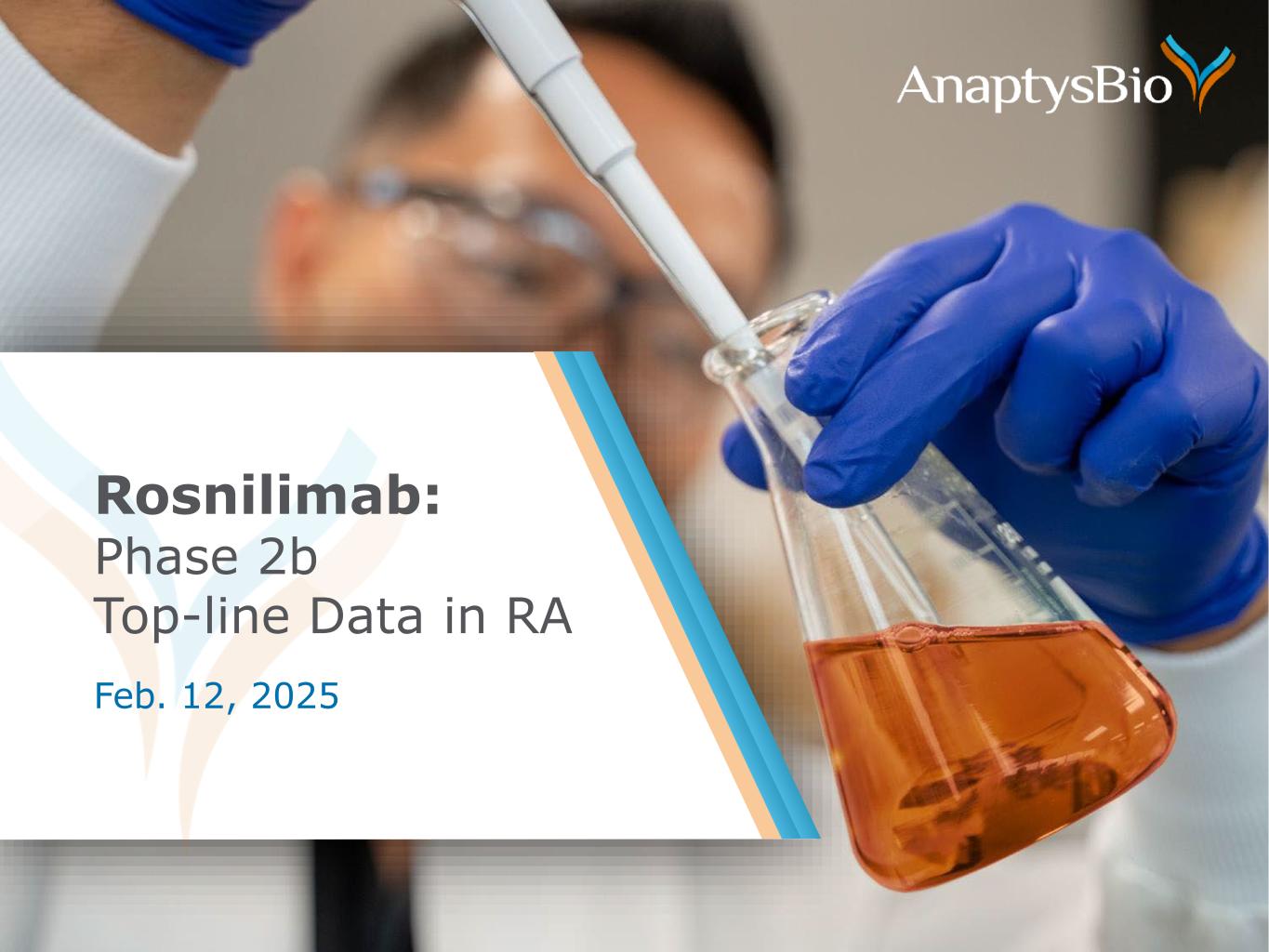
Feb. 12, 2025 Rosnilimab: Phase 2b Top-line Data in RA
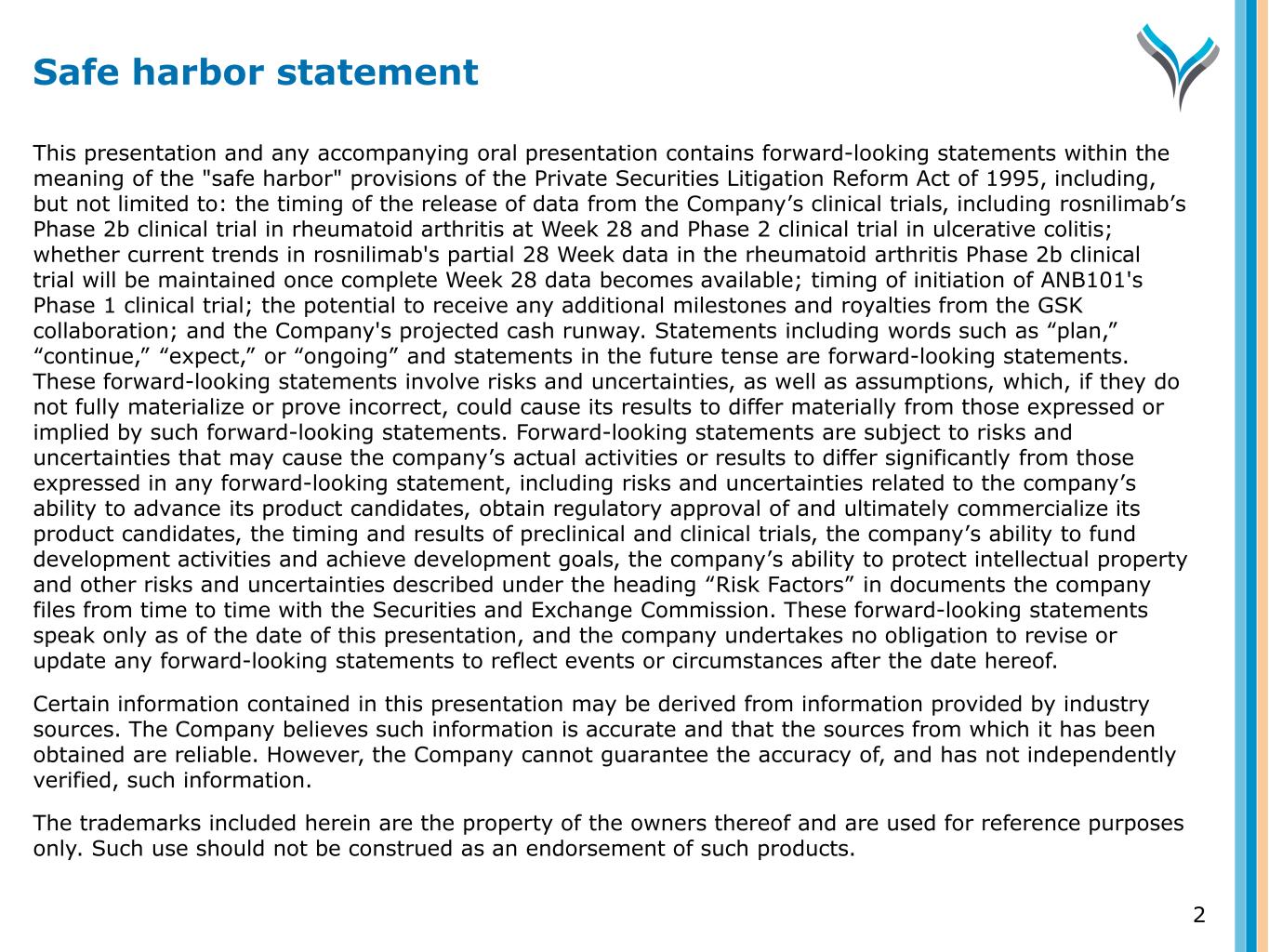
This presentation and any accompanying oral presentation contains forward-looking statements within the meaning of the "safe harbor" provisions of the Private Securities Litigation Reform Act of 1995, including, but not limited to: the timing of the release of data from the Company’s clinical trials, including rosnilimab’s Phase 2b clinical trial in rheumatoid arthritis at Week 28 and Phase 2 clinical trial in ulcerative colitis; whether current trends in rosnilimab's partial 28 Week data in the rheumatoid arthritis Phase 2b clinical trial will be maintained once complete Week 28 data becomes available; timing of initiation of ANB101's Phase 1 clinical trial; the potential to receive any additional milestones and royalties from the GSK collaboration; and the Company's projected cash runway. Statements including words such as “plan,” “continue,” “expect,” or “ongoing” and statements in the future tense are forward-looking statements. These forward-looking statements involve risks and uncertainties, as well as assumptions, which, if they do not fully materialize or prove incorrect, could cause its results to differ materially from those expressed or implied by such forward-looking statements. Forward-looking statements are subject to risks and uncertainties that may cause the company’s actual activities or results to differ significantly from those expressed in any forward-looking statement, including risks and uncertainties related to the company’s ability to advance its product candidates, obtain regulatory approval of and ultimately commercialize its product candidates, the timing and results of preclinical and clinical trials, the company’s ability to fund development activities and achieve development goals, the company’s ability to protect intellectual property and other risks and uncertainties described under the heading “Risk Factors” in documents the company files from time to time with the Securities and Exchange Commission. These forward-looking statements speak only as of the date of this presentation, and the company undertakes no obligation to revise or update any forward-looking statements to reflect events or circumstances after the date hereof. Certain information contained in this presentation may be derived from information provided by industry sources. The Company believes such information is accurate and that the sources from which it has been obtained are reliable. However, the Company cannot guarantee the accuracy of, and has not independently verified, such information. The trademarks included herein are the property of the owners thereof and are used for reference purposes only. Such use should not be construed as an endorsement of such products. 2 Safe harbor statement
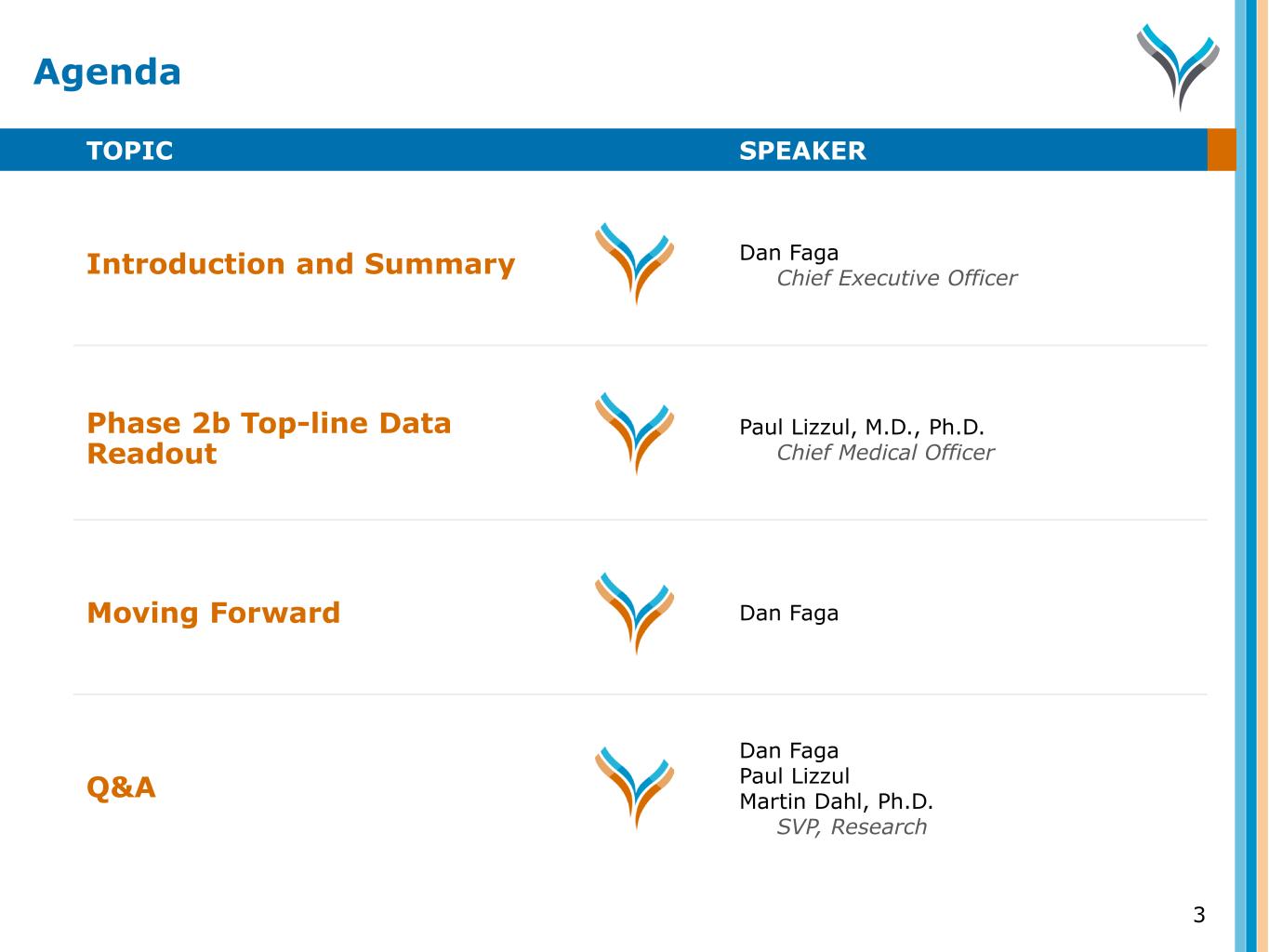
TOPIC SPEAKER Introduction and Summary Dan Faga Chief Executive Officer Phase 2b Top-line Data Readout Paul Lizzul, M.D., Ph.D. Chief Medical Officer Moving Forward Dan Faga Q&A Dan Faga Paul Lizzul Martin Dahl, Ph.D. SVP, Research Agenda 3

• Statistically significant on primary endpoint (DAS28-CRP) at Week 12 as well as on key secondary endpoints at both Week 12 and Week 14 • Absolute Week 12 and Week 14 data surpass our benchmarked Phase 2 target product profile • CDAI LDA responders3 appear to show sustained CDAI LDA and ACR50 and potentially deepening ACR70 responses out to Week 28 • Rosnilimab was safe and well tolerated 4 61% 52% 30% 73% 56% 36% 63% 56% 39% 58% 59% 37% 52% 50% 27% 43% 43% 23% 20% 30% 40% 50% 60% 70% 80% % o f P a ti e n ts Rosnilimab - 100mg Q4W Rosnilimab - 400mg Q4W Rosnilimab - 600mg Q2W Rinvoq Orencia Kevzara Bio-Experienced Patients: Absolute Rosnilimab Week 14 vs. Competitors H2H Week 24 Week 14 Week 24 Week 14 Week 24 Week 14 Week 24 CDAI LDA ACR50 ACR70 Legend 1 1 2 1. SELECT-CHOICE Phase 3 study; NRI data 2. ContRAst-3 Phase 3 study; Missing data in ContRAst-3 handled with multiple imputation method 3. Only Week 14 CDAI LDA responders initially randomized to rosnilimab were eligible to stay on treatment from Week 14 to Week 28; As of Dec. 10, 2024 CDAI = Clinical Diseases Activity Index; LDA = Low Disease Activity. Rosnilimab Week 14 efficacy is highest ever reported, surpassing all-active H2H comparator studies at Week 24
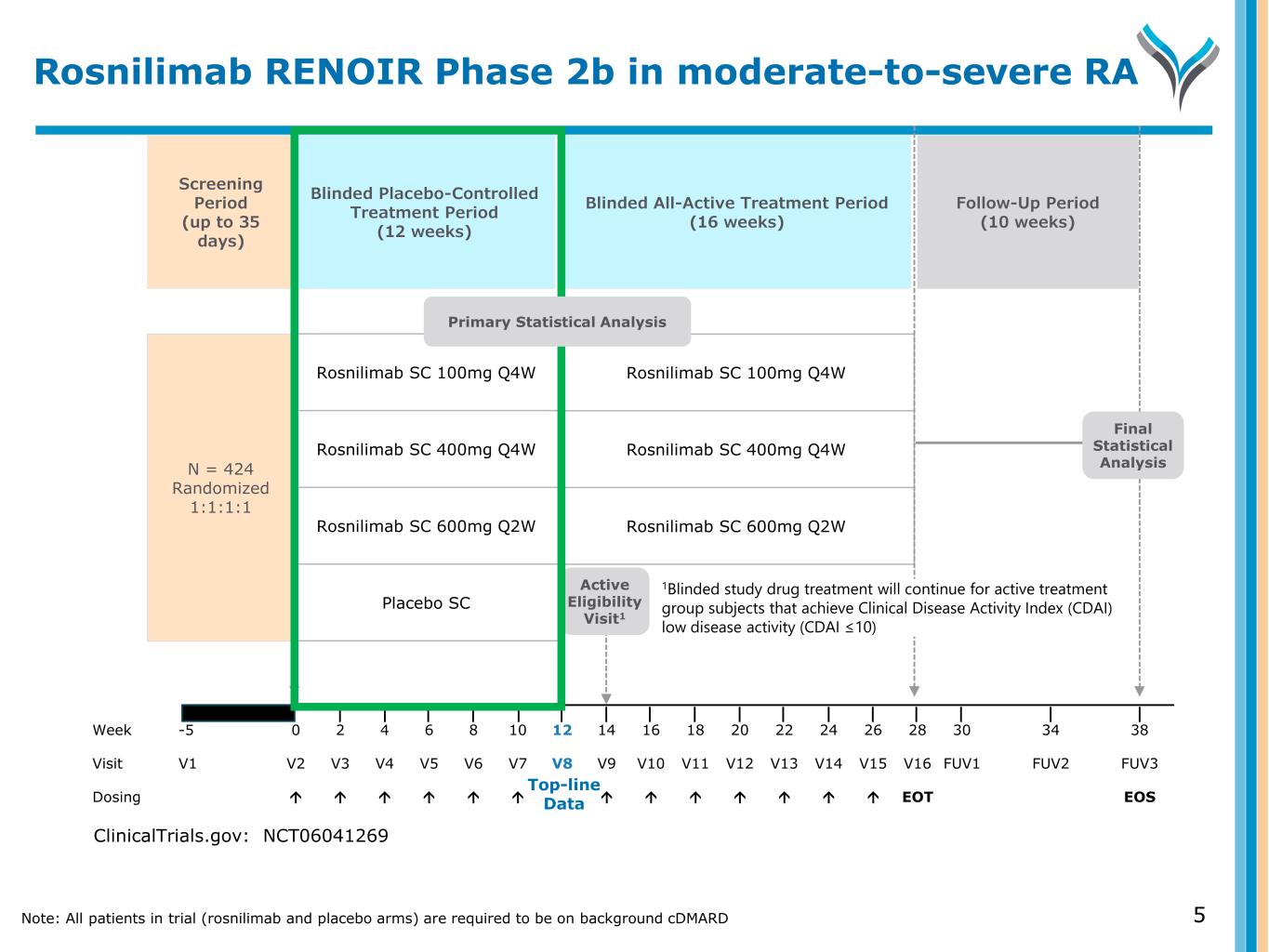
5 Screening Period (up to 35 days) Blinded Placebo-Controlled Treatment Period (12 weeks) Follow-Up Period (10 weeks) Blinded All-Active Treatment Period (16 weeks) Week -5 0 2 4 6 8 10 12 14 16 18 20 22 24 26 28 30 34 38 Visit V1 V2 V3 V4 V5 V6 V7 V8 V9 V10 V11 V12 V13 V14 V15 V16 FUV1 FUV2 FUV3 Dosing EOT EOS Rosnilimab SC 100mg Q4W Rosnilimab SC 400mg Q4W Rosnilimab SC 600mg Q2W Placebo SC Rosnilimab SC 100mg Q4W Rosnilimab SC 400mg Q4W Rosnilimab SC 600mg Q2W N = 424 Randomized 1:1:1:1 Final Statistical Analysis Top-line Data 1Blinded study drug treatment will continue for active treatment group subjects that achieve Clinical Disease Activity Index (CDAI) low disease activity (CDAI ≤10) Active Eligibility Visit1 Primary Statistical Analysis Note: All patients in trial (rosnilimab and placebo arms) are required to be on background cDMARD ClinicalTrials.gov: NCT06041269 Rosnilimab RENOIR Phase 2b in moderate-to-severe RA

6 Participant disposition through Week 12 *ITT – Intent-to-Treat (all randomized participants) ITT* (n=424) Placebo, n=106 Naïve – n=62 (59%) Experienced – n=44 (42%) Discontinued treatment, n=9 (8%) Primary reason: Adverse events, n=1 Disease progression, n=0 Withdrawal of consent, n=7 Other, n=1 Completed – n=97 Rosnilimab 100mg Q4W, n=106 Naïve – n=62 (59%) Experienced – n=44 (42%) Discontinued treatment, n=5 (5%) Primary reason: Adverse events, n=1 Disease progression, n=1 Withdrawal of consent, n=3 Other, n=0 Completed – n=101 Rosnilimab 400mg Q4W, n=107 Naïve – n=62 (58%) Experienced – n=45 (42%) Discontinued treatment, n=6 (6%) Primary reason: Adverse events, n=2 Disease progression, n=2 Withdrawal of consent, n=1 Other, n=1 Completed – n=101 Rosnilimab 600mg Q2W, n=105 Naïve – n=64 (61%) Experienced – n=41 (39%) Discontinued treatment, n=8 (8%) Primary reason: Adverse events, n=2 Disease progression, n=2 Withdrawal of consent, n=2 Other, n=2 Completed – n=97
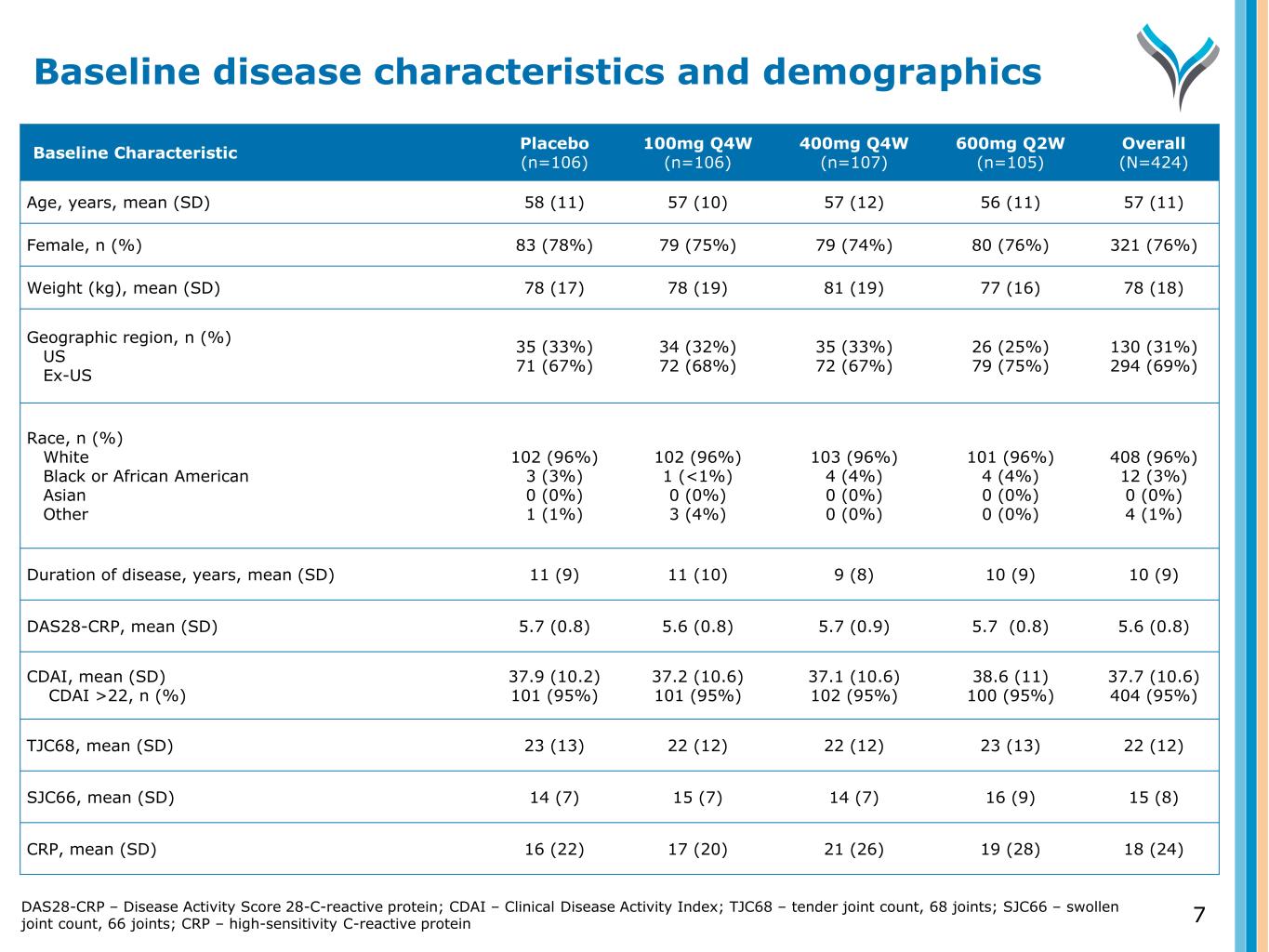
7 Baseline Characteristic Placebo (n=106) 100mg Q4W (n=106) 400mg Q4W (n=107) 600mg Q2W (n=105) Overall (N=424) Age, years, mean (SD) 58 (11) 57 (10) 57 (12) 56 (11) 57 (11) Female, n (%) 83 (78%) 79 (75%) 79 (74%) 80 (76%) 321 (76%) Weight (kg), mean (SD) 78 (17) 78 (19) 81 (19) 77 (16) 78 (18) Geographic region, n (%) US Ex-US 35 (33%) 71 (67%) 34 (32%) 72 (68%) 35 (33%) 72 (67%) 26 (25%) 79 (75%) 130 (31%) 294 (69%) Race, n (%) White Black or African American Asian Other 102 (96%) 3 (3%) 0 (0%) 1 (1%) 102 (96%) 1 (<1%) 0 (0%) 3 (4%) 103 (96%) 4 (4%) 0 (0%) 0 (0%) 101 (96%) 4 (4%) 0 (0%) 0 (0%) 408 (96%) 12 (3%) 0 (0%) 4 (1%) Duration of disease, years, mean (SD) 11 (9) 11 (10) 9 (8) 10 (9) 10 (9) DAS28-CRP, mean (SD) 5.7 (0.8) 5.6 (0.8) 5.7 (0.9) 5.7 (0.8) 5.6 (0.8) CDAI, mean (SD) CDAI >22, n (%) 37.9 (10.2) 101 (95%) 37.2 (10.6) 101 (95%) 37.1 (10.6) 102 (95%) 38.6 (11) 100 (95%) 37.7 (10.6) 404 (95%) TJC68, mean (SD) 23 (13) 22 (12) 22 (12) 23 (13) 22 (12) SJC66, mean (SD) 14 (7) 15 (7) 14 (7) 16 (9) 15 (8) CRP, mean (SD) 16 (22) 17 (20) 21 (26) 19 (28) 18 (24) Baseline disease characteristics and demographics DAS28-CRP – Disease Activity Score 28-C-reactive protein; CDAI – Clinical Disease Activity Index; TJC68 – tender joint count, 68 joints; SJC66 – swollen joint count, 66 joints; CRP – high-sensitivity C-reactive protein
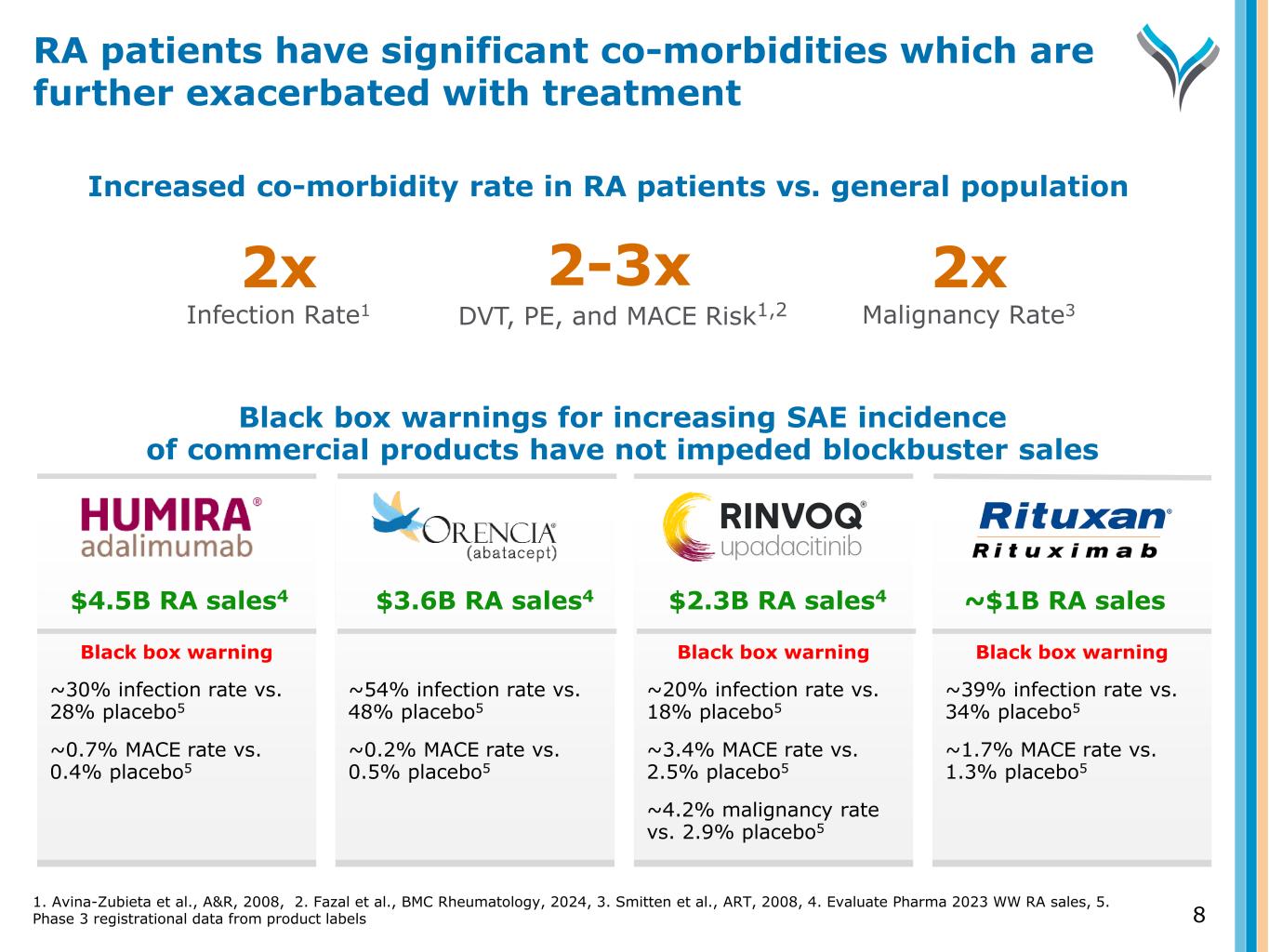
Black box warnings for increasing SAE incidence of commercial products have not impeded blockbuster sales Black box warning ~30% infection rate vs. 28% placebo5 ~0.7% MACE rate vs. 0.4% placebo5 ~54% infection rate vs. 48% placebo5 ~0.2% MACE rate vs. 0.5% placebo5 Black box warning ~20% infection rate vs. 18% placebo5 ~3.4% MACE rate vs. 2.5% placebo5 ~4.2% malignancy rate vs. 2.9% placebo5 Black box warning ~39% infection rate vs. 34% placebo5 ~1.7% MACE rate vs. 1.3% placebo5 8 Increased co-morbidity rate in RA patients vs. general population 2-3x DVT, PE, and MACE Risk1,2 2x Infection Rate1 2x Malignancy Rate3 $4.5B RA sales4 $3.6B RA sales4 $2.3B RA sales4 ~$1B RA sales 1. Avina-Zubieta et al., A&R, 2008, 2. Fazal et al., BMC Rheumatology, 2024, 3. Smitten et al., ART, 2008, 4. Evaluate Pharma 2023 WW RA sales, 5. Phase 3 registrational data from product labels RA patients have significant co-morbidities which are further exacerbated with treatment

9 Adverse Events through Week 12, n (%) Placebo (n=106) 100mg Q4W (n=106) 400mg Q4W (n=107) 600mg Q2W (n=105) Participants with any AE, n (%) 36 (34%) 51 (48%) 48 (45%) 38 (36%) Any SAE1 1 (1%) 1 (1%) 1 (1%) 3 (3%) Any Drug-Related SAE 1 (1%) 0 (0%) 0 (0%) 0 (0%) Severe AE2 2 (2%) 1 (1%) 0 (0%) 4 (4%) Drug-Related AE 18 (17%) 13 (12%) 18 (17%) 17 (16%) Infections 14 (13%) 24 (23%) 21 (20%) 12 (11%) AE Leading to Treatment Discontinuation 1 (1%) 1 (1%) 2 (2%) 2 (2%) Participants with any AEs >5%, n Headache 4 (4%) 7 (7%) 6 (6%) 4 (4%) Upper respiratory tract infection 1 (1%) 7 (7%) 2 (2%) 3 (3%) • No malignancies • No MACE • No elevation of serious infections vs. placebo • No anaphylaxis or systemic hypersensitivity associated with rosnilimab • Low incidence of injection site reactions and similar to placebo Safety profile up to Week 28 remains consistent with reported profile through Week 12 1. SAEs (severe unless otherwise noted): pneumonia – mild (100 mg Q4W); meniscus tear – moderate (400 mg Q4W); anaphylaxis from wasp sting, ureter stone, and cholecystitis/pericardial effusion (600mg Q2W) and cellulitis/diarrhea (placebo) 2. Severe AE (excluding SAEs): flu (100mg Q4W); RA flare (600mg Q2W); macular degeneration/retinal hemorrhage (placebo) Rosnilimab was safe and well tolerated with similar adverse event rates vs. placebo
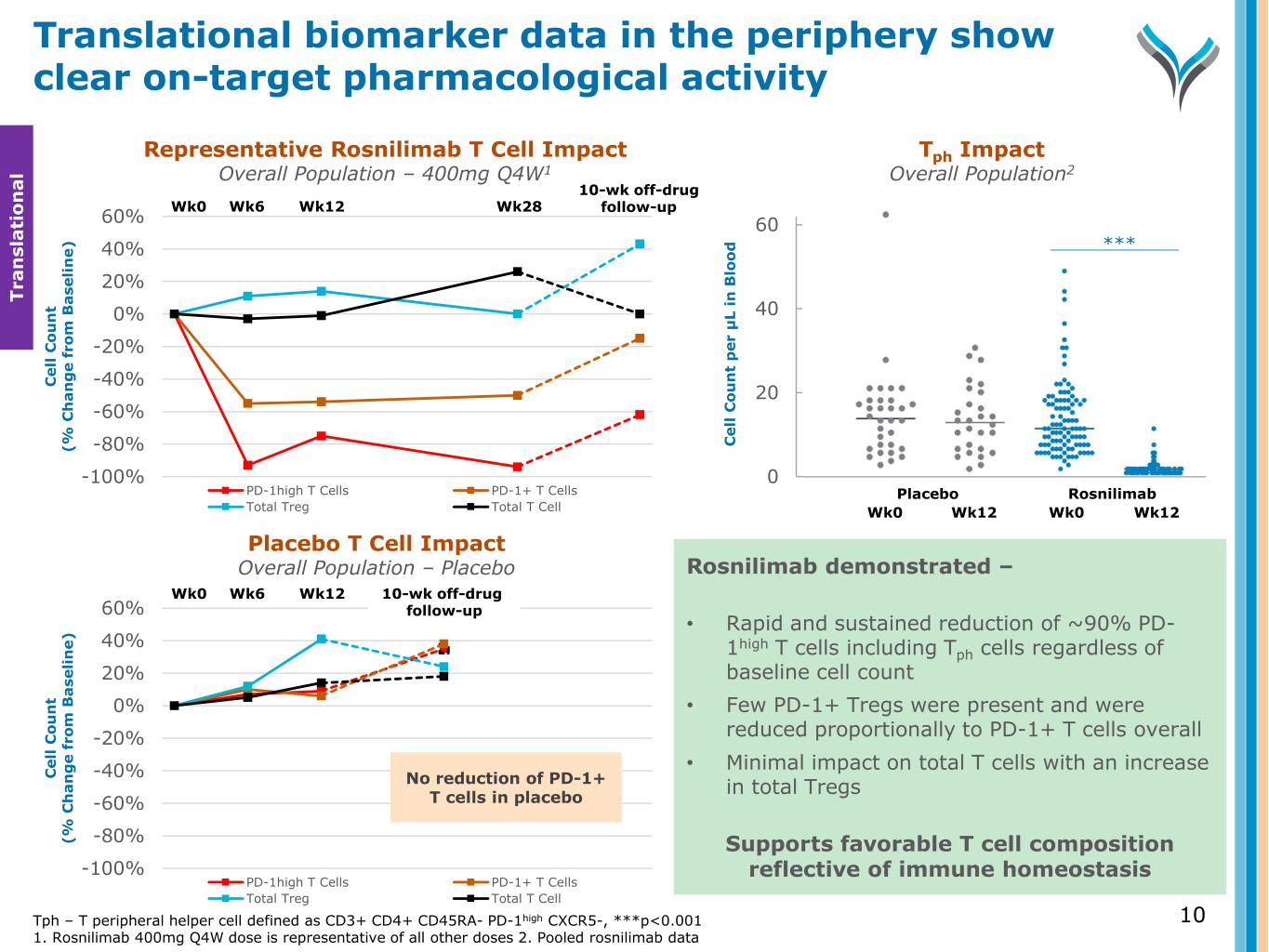
10 -100% -80% -60% -40% -20% 0% 20% 40% 60% C el l C o u n t (% C h a n g e fr o m B a se li n e) PD-1high T Cells PD-1+ T Cells Total Treg Total T Cell Representative Rosnilimab T Cell Impact Overall Population – 400mg Q4W1 Wk0 Wk6 Wk12 10-wk off-drug follow-up Translational biomarker data in the periphery show clear on-target pharmacological activity Placebo T Cell Impact Overall Population – Placebo Rosnilimab demonstrated – • Rapid and sustained reduction of ~90% PD- 1high T cells including Tph cells regardless of baseline cell count • Few PD-1+ Tregs were present and were reduced proportionally to PD-1+ T cells overall • Minimal impact on total T cells with an increase in total Tregs Supports favorable T cell composition reflective of immune homeostasis 0 20 40 60 C el l C o u n t p er μ L in B lo o d Tph Impact Overall Population2 Wk0 Wk12 Wk0 Wk12 -100% -80% -60% -40% -20% 0% 20% 40% 60% C el l C o u n t (% C h a n g e fr o m B a se li n e) PD-1high T Cells PD-1+ T Cells Total Treg Total T Cell Wk28 Wk0 Wk6 Wk12 10-wk off-drug follow-up Tph – T peripheral helper cell defined as CD3+ CD4+ CD45RA- PD-1high CXCR5-, ***p<0.001 1. Rosnilimab 400mg Q4W dose is representative of all other doses 2. Pooled rosnilimab data Placebo Rosnilimab No reduction of PD-1+ T cells in placebo *** T ra n sl a ti o n a l
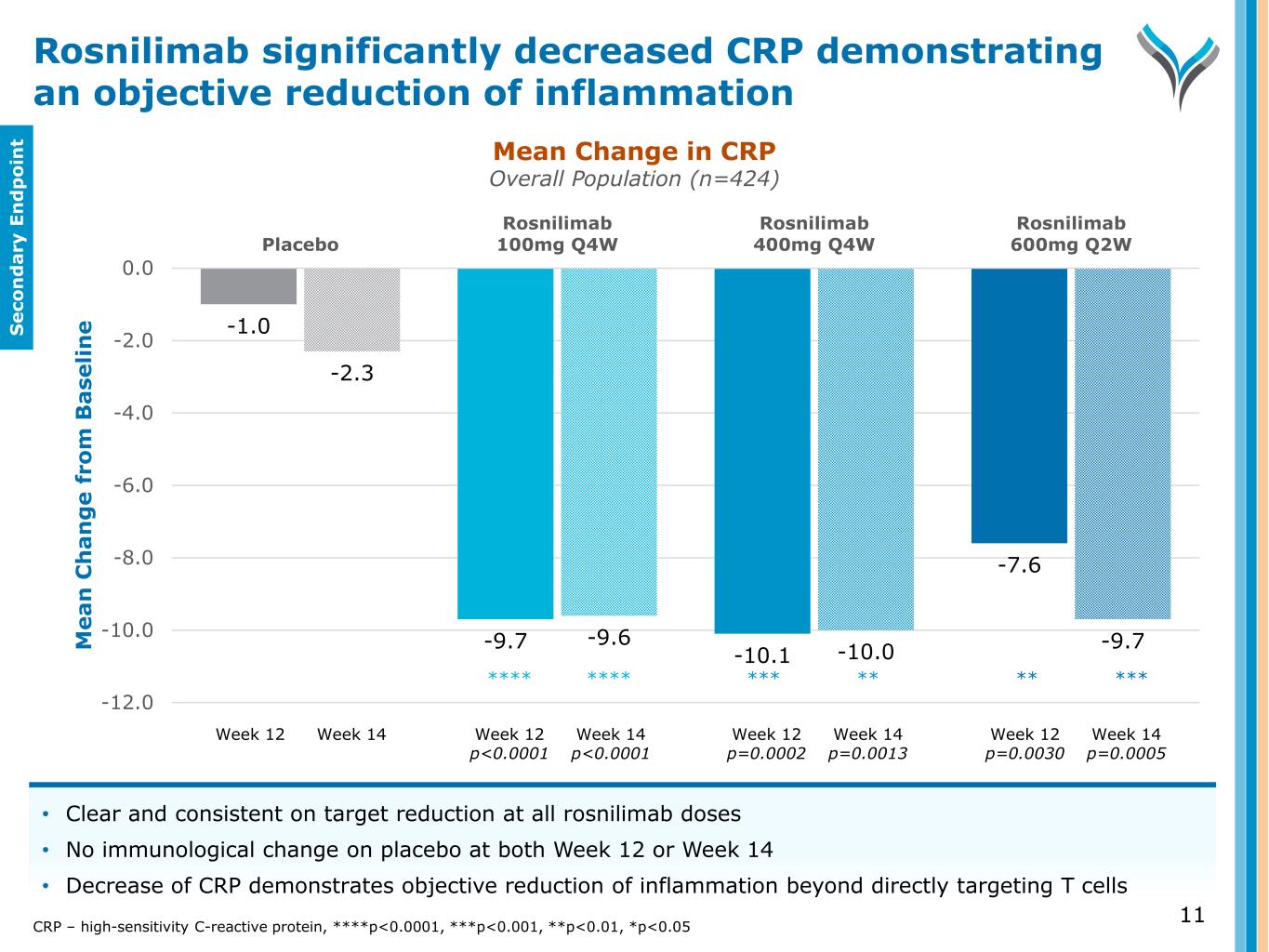
11 -1.0 -9.7 -10.1 -7.6 -2.3 -9.6 -10.0 -9.7 -12.0 -10.0 -8.0 -6.0 -4.0 -2.0 0.0 Placebo Rosnilimab 100mg Q4W Rosnilimab 400mg Q4W Rosnilimab 600mg Q2W M e a n C h a n g e f ro m B a se li n e • Clear and consistent on target reduction at all rosnilimab doses • No immunological change on placebo at both Week 12 or Week 14 • Decrease of CRP demonstrates objective reduction of inflammation beyond directly targeting T cells CRP – high-sensitivity C-reactive protein, ****p<0.0001, ***p<0.001, **p<0.01, *p<0.05 Week 12 Week 14 Week 12 p<0.0001 Week 14 p<0.0001 Week 12 p=0.0002 Week 14 p=0.0013 Week 12 p=0.0030 Week 14 p=0.0005 **** **** *** ** ** *** Rosnilimab significantly decreased CRP demonstrating an objective reduction of inflammation Mean Change in CRP Overall Population (n=424) S e co n d a ry E n d p o in t
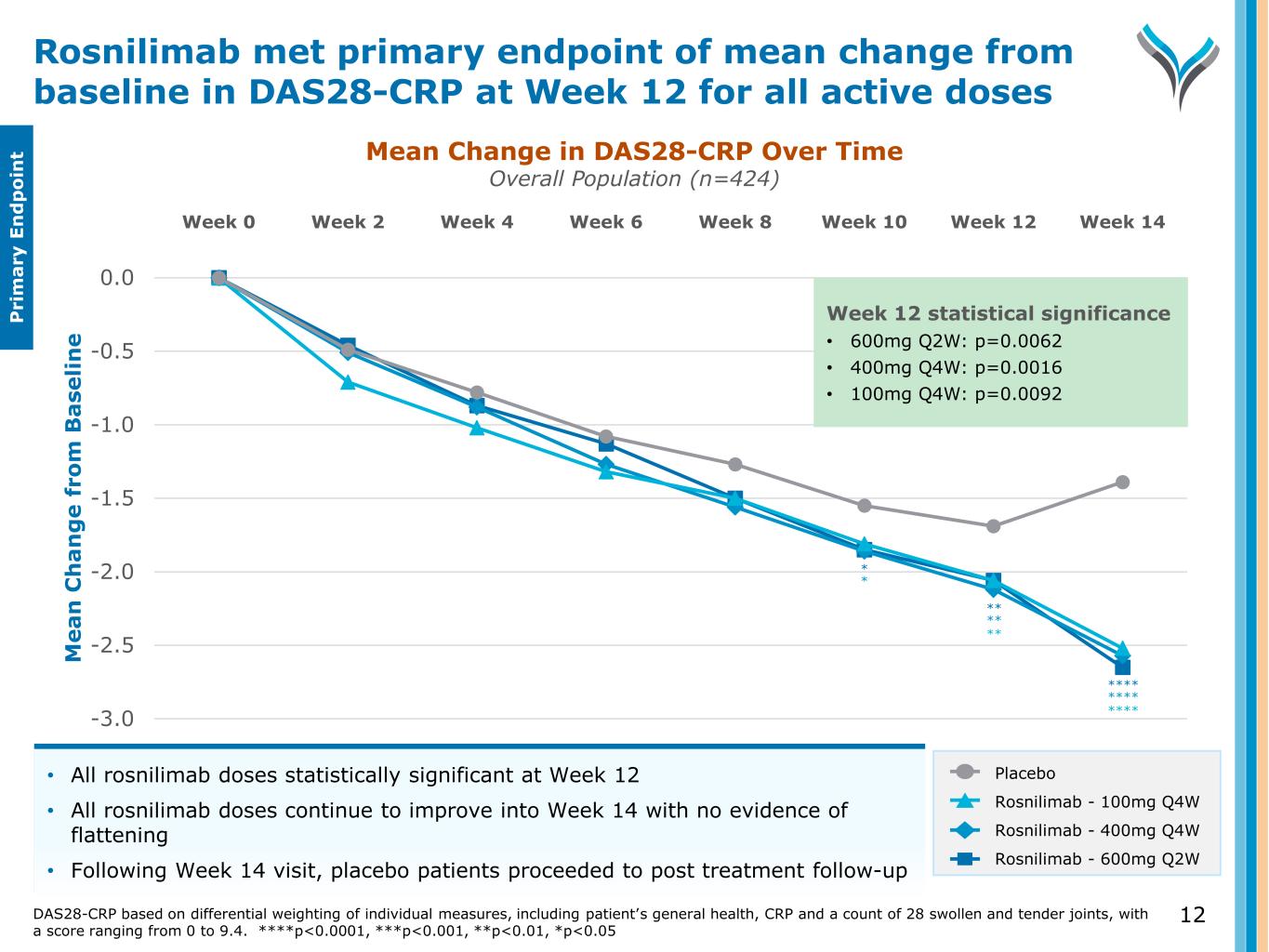
12 -3.0 -2.5 -2.0 -1.5 -1.0 -0.5 0.0 Week 0 Week 2 Week 4 Week 6 Week 8 Week 10 Week 12 Week 14 M e a n C h a n g e f ro m B a se li n e • All rosnilimab doses statistically significant at Week 12 • All rosnilimab doses continue to improve into Week 14 with no evidence of flattening • Following Week 14 visit, placebo patients proceeded to post treatment follow-up Placebo Rosnilimab - 100mg Q4W Rosnilimab - 400mg Q4W Rosnilimab - 600mg Q2W DAS28-CRP based on differential weighting of individual measures, including patient’s general health, CRP and a count of 28 swollen and tender joints, with a score ranging from 0 to 9.4. ****p<0.0001, ***p<0.001, **p<0.01, *p<0.05 P ri m a ry E n d p o in t ** Week 12 statistical significance • 600mg Q2W: p=0.0062 • 400mg Q4W: p=0.0016 • 100mg Q4W: p=0.0092 ** ** * * **** **** **** Mean Change in DAS28-CRP Over Time Overall Population (n=424) Rosnilimab met primary endpoint of mean change from baseline in DAS28-CRP at Week 12 for all active doses
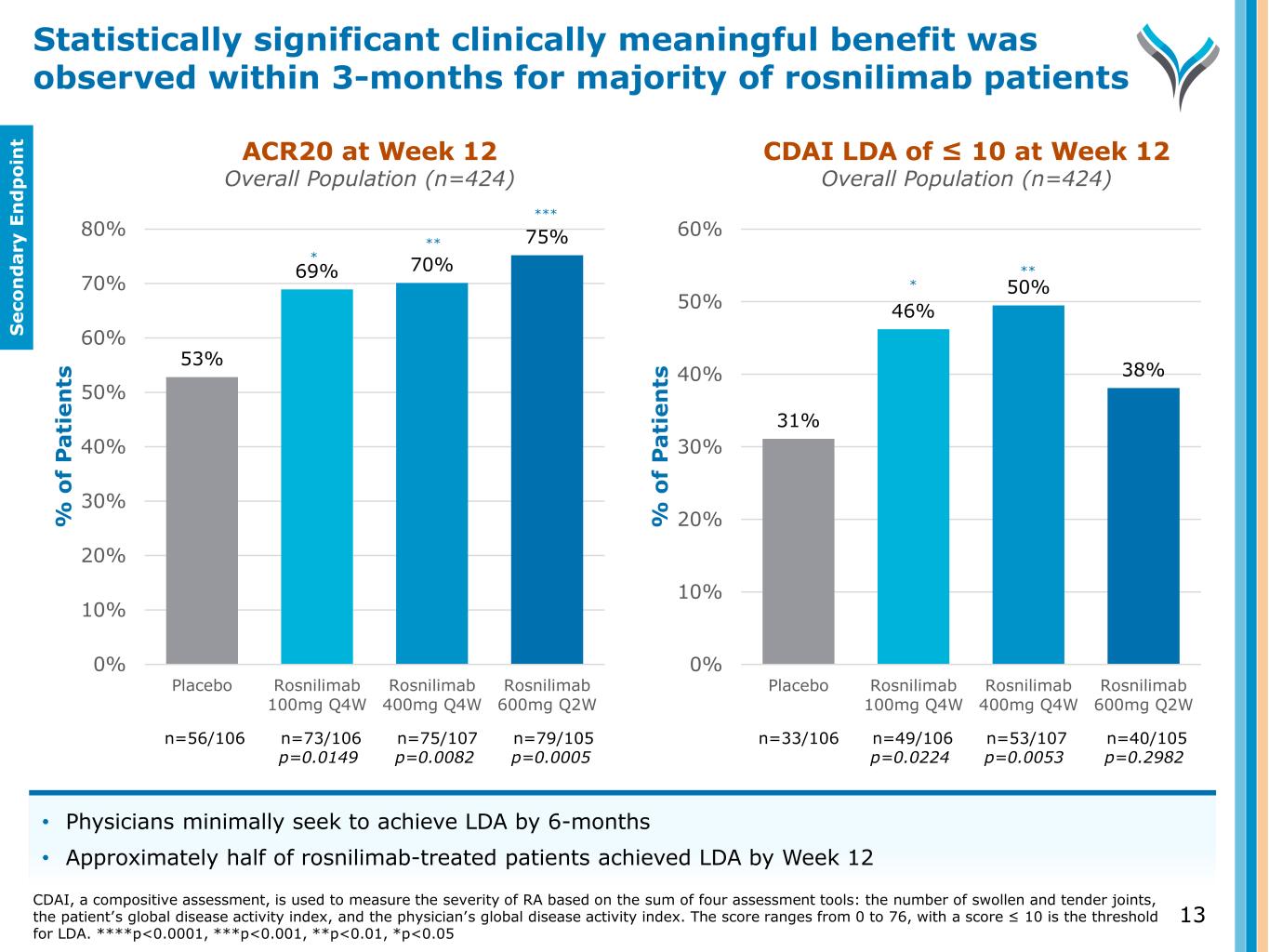
13 31% 46% 50% 38% 0% 10% 20% 30% 40% 50% 60% Placebo Rosnilimab 100mg Q4W Rosnilimab 400mg Q4W Rosnilimab 600mg Q2W % o f P a ti e n ts • Physicians minimally seek to achieve LDA by 6-months • Approximately half of rosnilimab-treated patients achieved LDA by Week 12 CDAI, a compositive assessment, is used to measure the severity of RA based on the sum of four assessment tools: the number of swollen and tender joints, the patient’s global disease activity index, and the physician’s global disease activity index. The score ranges from 0 to 76, with a score ≤ 10 is the threshold for LDA. ****p<0.0001, ***p<0.001, **p<0.01, *p<0.05 Statistically significant clinically meaningful benefit was observed within 3-months for majority of rosnilimab patients 53% 69% 70% 75% 0% 10% 20% 30% 40% 50% 60% 70% 80% Placebo Rosnilimab 100mg Q4W Rosnilimab 400mg Q4W Rosnilimab 600mg Q2W % o f P a ti e n ts n=33/106 n=49/106 p=0.0224 n=53/107 p=0.0053 n=40/105 p=0.2982 n=56/106 n=73/106 p=0.0149 n=75/107 p=0.0082 n=79/105 p=0.0005 *** ** * ** * S e co n d a ry E n d p o in t CDAI LDA of ≤ 10 at Week 12 Overall Population (n=424) ACR20 at Week 12 Overall Population (n=424)
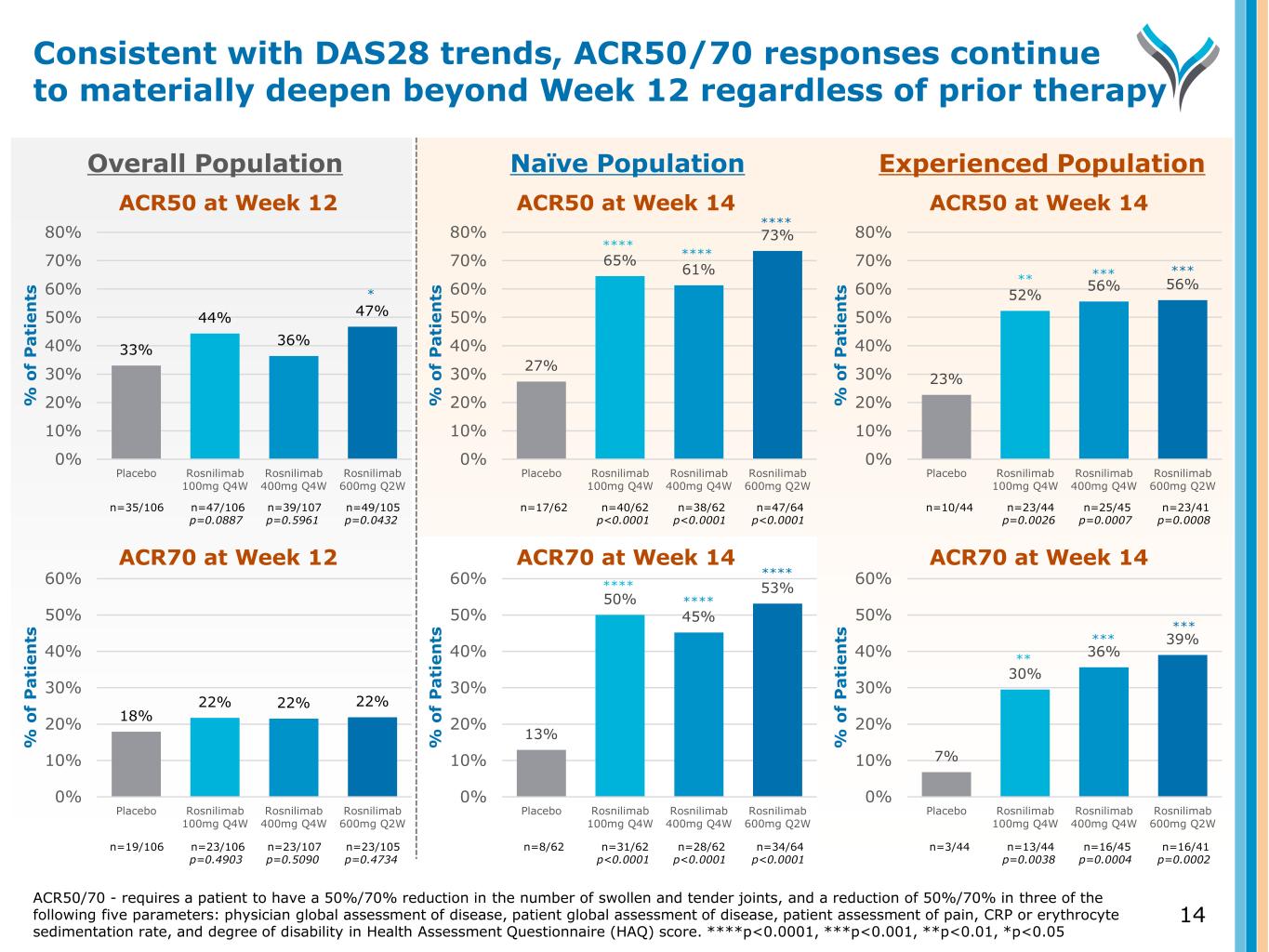
14 33% 44% 36% 47% 0% 10% 20% 30% 40% 50% 60% 70% 80% Placebo Rosnilimab 100mg Q4W Rosnilimab 400mg Q4W Rosnilimab 600mg Q2W % o f P a ti e n ts 27% 65% 61% 73% 0% 10% 20% 30% 40% 50% 60% 70% 80% Placebo Rosnilimab 100mg Q4W Rosnilimab 400mg Q4W Rosnilimab 600mg Q2W % o f P a ti e n ts 23% 52% 56% 56% 0% 10% 20% 30% 40% 50% 60% 70% 80% Placebo Rosnilimab 100mg Q4W Rosnilimab 400mg Q4W Rosnilimab 600mg Q2W % o f P a ti e n ts ACR50 at Week 12 ACR50 at Week 14 ACR50 at Week 14 18% 22% 22% 22% 0% 10% 20% 30% 40% 50% 60% Placebo Rosnilimab 100mg Q4W Rosnilimab 400mg Q4W Rosnilimab 600mg Q2W % o f P a ti e n ts 13% 50% 45% 53% 0% 10% 20% 30% 40% 50% 60% Placebo Rosnilimab 100mg Q4W Rosnilimab 400mg Q4W Rosnilimab 600mg Q2W % o f P a ti e n ts 7% 30% 36% 39% 0% 10% 20% 30% 40% 50% 60% Placebo Rosnilimab 100mg Q4W Rosnilimab 400mg Q4W Rosnilimab 600mg Q2W % o f P a ti e n ts ACR50/70 - requires a patient to have a 50%/70% reduction in the number of swollen and tender joints, and a reduction of 50%/70% in three of the following five parameters: physician global assessment of disease, patient global assessment of disease, patient assessment of pain, CRP or erythrocyte sedimentation rate, and degree of disability in Health Assessment Questionnaire (HAQ) score. ****p<0.0001, ***p<0.001, **p<0.01, *p<0.05 ACR70 at Week 12 ACR70 at Week 14 ACR70 at Week 14 Overall Population Naïve Population Experienced Population Consistent with DAS28 trends, ACR50/70 responses continue to materially deepen beyond Week 12 regardless of prior therapy n=35/106 n=47/106 p=0.0887 n=39/107 p=0.5961 n=49/105 p=0.0432 n=17/62 n=40/62 p<0.0001 n=38/62 p<0.0001 n=47/64 p<0.0001 n=10/44 n=23/44 p=0.0026 n=25/45 p=0.0007 n=23/41 p=0.0008 n=19/106 n=23/106 p=0.4903 n=23/107 p=0.5090 n=23/105 p=0.4734 n=8/62 n=31/62 p<0.0001 n=28/62 p<0.0001 n=34/64 p<0.0001 n=3/44 n=13/44 p=0.0038 n=16/45 p=0.0004 n=16/41 p=0.0002 **** **** **** **** **** **** *** *** *** *** ** ** *
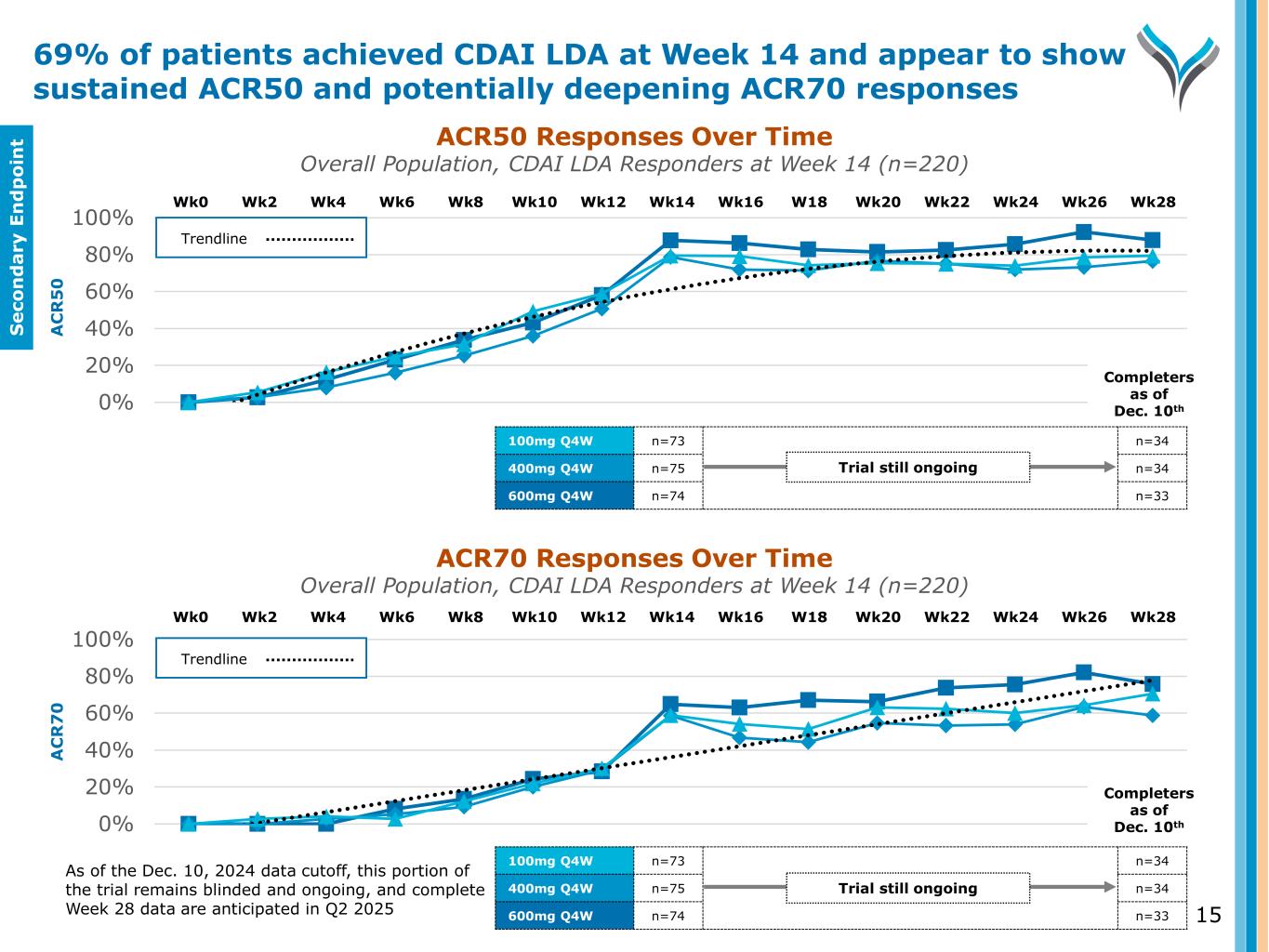
0% 20% 40% 60% 80% 100% A C R 5 0 Wk0 Wk2 Wk4 Wk6 Wk8 Wk10 Wk12 Wk14 Wk16 W18 Wk20 Wk22 Wk24 Wk26 Wk28 100mg Q4W n=73 n=34 400mg Q4W n=75 n=34 600mg Q4W n=74 n=33 0% 20% 40% 60% 80% 100% A C R 7 0 Wk0 Wk2 Wk4 Wk6 Wk8 Wk10 Wk12 Wk14 Wk16 W18 Wk20 Wk22 Wk24 Wk26 Wk28 Completers as of Dec. 10th 100mg Q4W n=73 n=34 400mg Q4W n=75 n=34 600mg Q4W n=74 n=33 Trial still ongoing ACR50 Responses Over Time Overall Population, CDAI LDA Responders at Week 14 (n=220) ACR70 Responses Over Time Overall Population, CDAI LDA Responders at Week 14 (n=220) Trendline S e co n d a ry E n d p o in t Trendline As of the Dec. 10, 2024 data cutoff, this portion of the trial remains blinded and ongoing, and complete Week 28 data are anticipated in Q2 2025 Trial still ongoing Completers as of Dec. 10th 69% of patients achieved CDAI LDA at Week 14 and appear to show sustained ACR50 and potentially deepening ACR70 responses 15
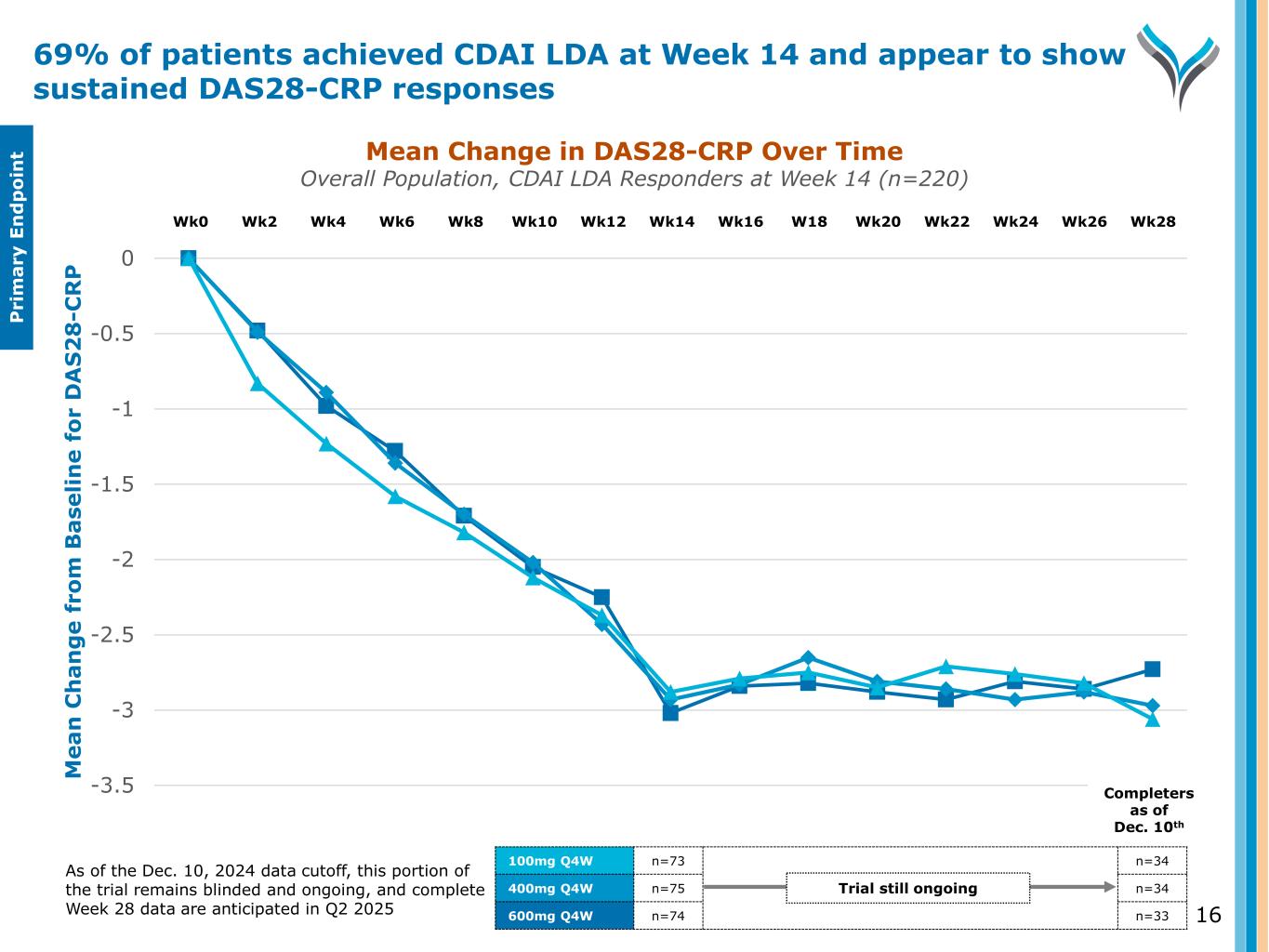
-3.5 -3 -2.5 -2 -1.5 -1 -0.5 0 M e a n C h a n g e f ro m B a se li n e f o r D A S 2 8 -C R P Wk0 Wk2 Wk4 Wk6 Wk8 Wk10 Wk12 Wk14 Wk16 W18 Wk20 Wk22 Wk24 Wk26 Wk28 100mg Q4W n=73 n=34 400mg Q4W n=75 n=34 600mg Q4W n=74 n=33 Mean Change in DAS28-CRP Over Time Overall Population, CDAI LDA Responders at Week 14 (n=220) P ri m a ry E n d p o in t As of the Dec. 10, 2024 data cutoff, this portion of the trial remains blinded and ongoing, and complete Week 28 data are anticipated in Q2 2025 Trial still ongoing Completers as of Dec. 10th 69% of patients achieved CDAI LDA at Week 14 and appear to show sustained DAS28-CRP responses 16
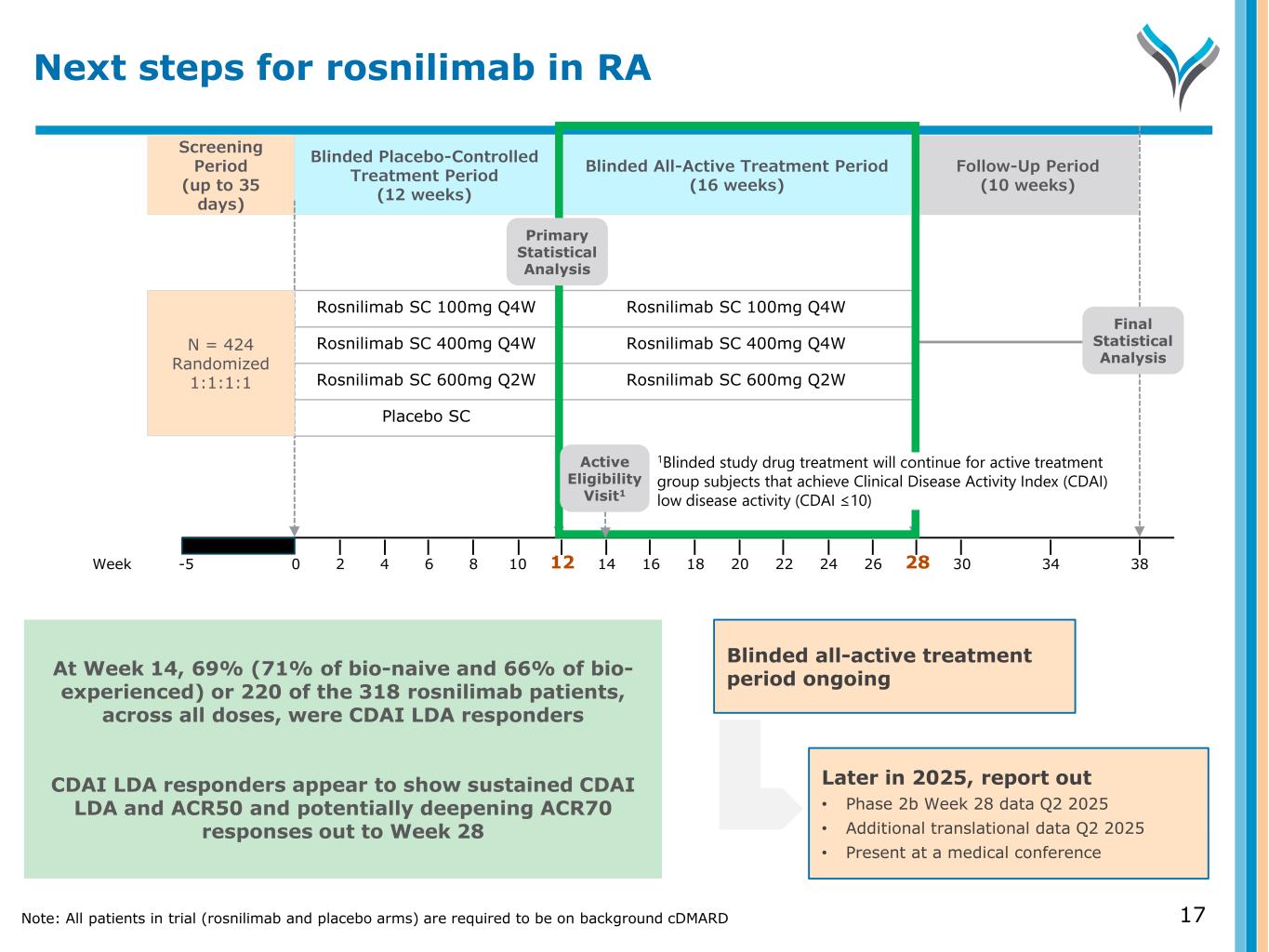
Screening Period (up to 35 days) Blinded Placebo-Controlled Treatment Period (12 weeks) Follow-Up Period (10 weeks) Blinded All-Active Treatment Period (16 weeks) Week -5 0 2 4 6 8 10 12 14 16 18 20 22 24 26 28 30 34 38 Rosnilimab SC 100mg Q4W Rosnilimab SC 400mg Q4W Rosnilimab SC 600mg Q2W Placebo SC Rosnilimab SC 100mg Q4W Rosnilimab SC 400mg Q4W Rosnilimab SC 600mg Q2W N = 424 Randomized 1:1:1:1 Final Statistical Analysis Next steps for rosnilimab in RA Primary Statistical Analysis Active Eligibility Visit1 1Blinded study drug treatment will continue for active treatment group subjects that achieve Clinical Disease Activity Index (CDAI) low disease activity (CDAI ≤10) At Week 14, 69% (71% of bio-naive and 66% of bio- experienced) or 220 of the 318 rosnilimab patients, across all doses, were CDAI LDA responders CDAI LDA responders appear to show sustained CDAI LDA and ACR50 and potentially deepening ACR70 responses out to Week 28 17Note: All patients in trial (rosnilimab and placebo arms) are required to be on background cDMARD Blinded all-active treatment period ongoing Later in 2025, report out • Phase 2b Week 28 data Q2 2025 • Additional translational data Q2 2025 • Present at a medical conference
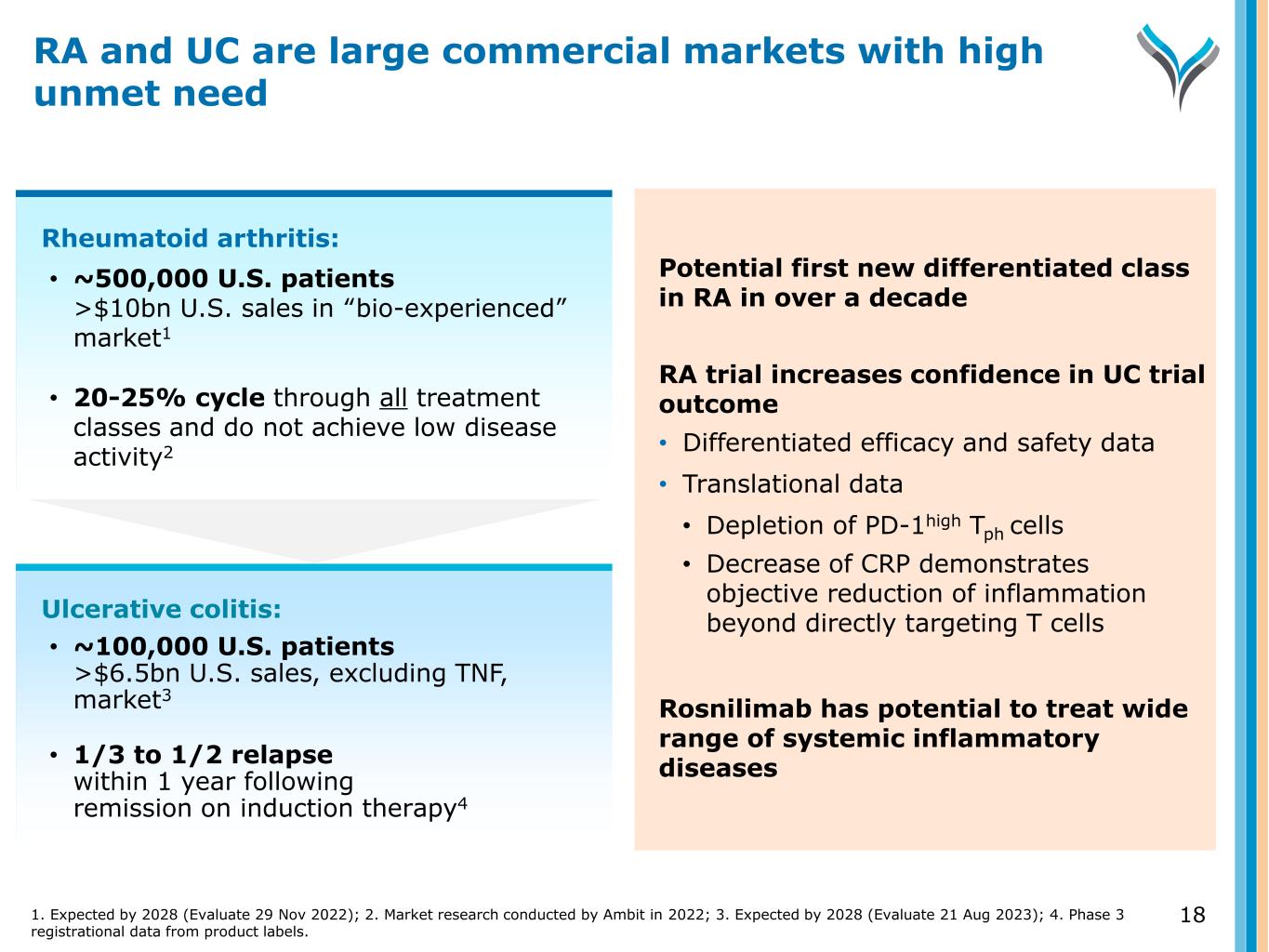
1. Expected by 2028 (Evaluate 29 Nov 2022); 2. Market research conducted by Ambit in 2022; 3. Expected by 2028 (Evaluate 21 Aug 2023); 4. Phase 3 registrational data from product labels. RA and UC are large commercial markets with high unmet need Potential first new differentiated class in RA in over a decade RA trial increases confidence in UC trial outcome • Differentiated efficacy and safety data • Translational data • Depletion of PD-1high Tph cells • Decrease of CRP demonstrates objective reduction of inflammation beyond directly targeting T cells Rosnilimab has potential to treat wide range of systemic inflammatory diseases 18 Ulcerative colitis: • ~100,000 U.S. patients >$6.5bn U.S. sales, excluding TNF, market3 • 1/3 to 1/2 relapse within 1 year following remission on induction therapy4 Rheumatoid arthritis: • ~500,000 U.S. patients >$10bn U.S. sales in “bio-experienced” market1 • 20-25% cycle through all treatment classes and do not achieve low disease activity2
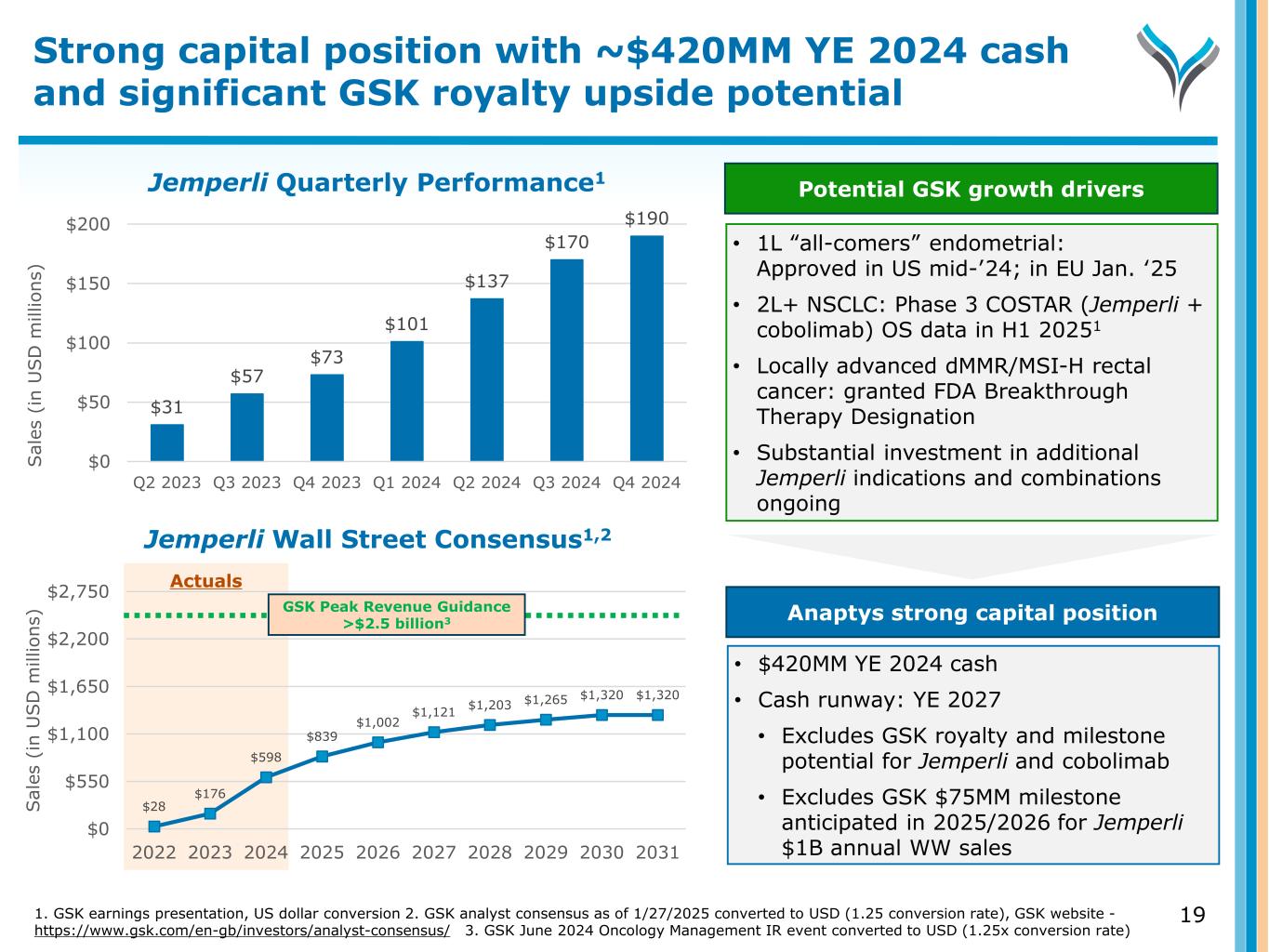
Actuals $31 $57 $73 $101 $137 $170 $190 $0 $50 $100 $150 $200 Q2 2023 Q3 2023 Q4 2023 Q1 2024 Q2 2024 Q3 2024 Q4 2024 S al es ( in U S D m ill io ns ) Jemperli Quarterly Performance1 1. GSK earnings presentation, US dollar conversion 2. GSK analyst consensus as of 1/27/2025 converted to USD (1.25 conversion rate), GSK website - https://www.gsk.com/en-gb/investors/analyst-consensus/ 3. GSK June 2024 Oncology Management IR event converted to USD (1.25x conversion rate) $28 $176 $598 $839 $1,002 $1,121 $1,203 $1,265 $1,320 $1,320 $0 $550 $1,100 $1,650 $2,200 $2,750 2022 2023 2024 2025 2026 2027 2028 2029 2030 2031 S al es ( in U S D m ill io ns ) Jemperli Wall Street Consensus1,2 Potential GSK growth drivers • 1L “all-comers” endometrial: Approved in US mid-’24; in EU Jan. ‘25 • 2L+ NSCLC: Phase 3 COSTAR (Jemperli + cobolimab) OS data in H1 20251 • Locally advanced dMMR/MSI-H rectal cancer: granted FDA Breakthrough Therapy Designation • Substantial investment in additional Jemperli indications and combinations ongoing GSK Peak Revenue Guidance >$2.5 billion3 Anaptys strong capital position • $420MM YE 2024 cash • Cash runway: YE 2027 • Excludes GSK royalty and milestone potential for Jemperli and cobolimab • Excludes GSK $75MM milestone anticipated in 2025/2026 for Jemperli $1B annual WW sales Strong capital position with ~$420MM YE 2024 cash and significant GSK royalty upside potential 19
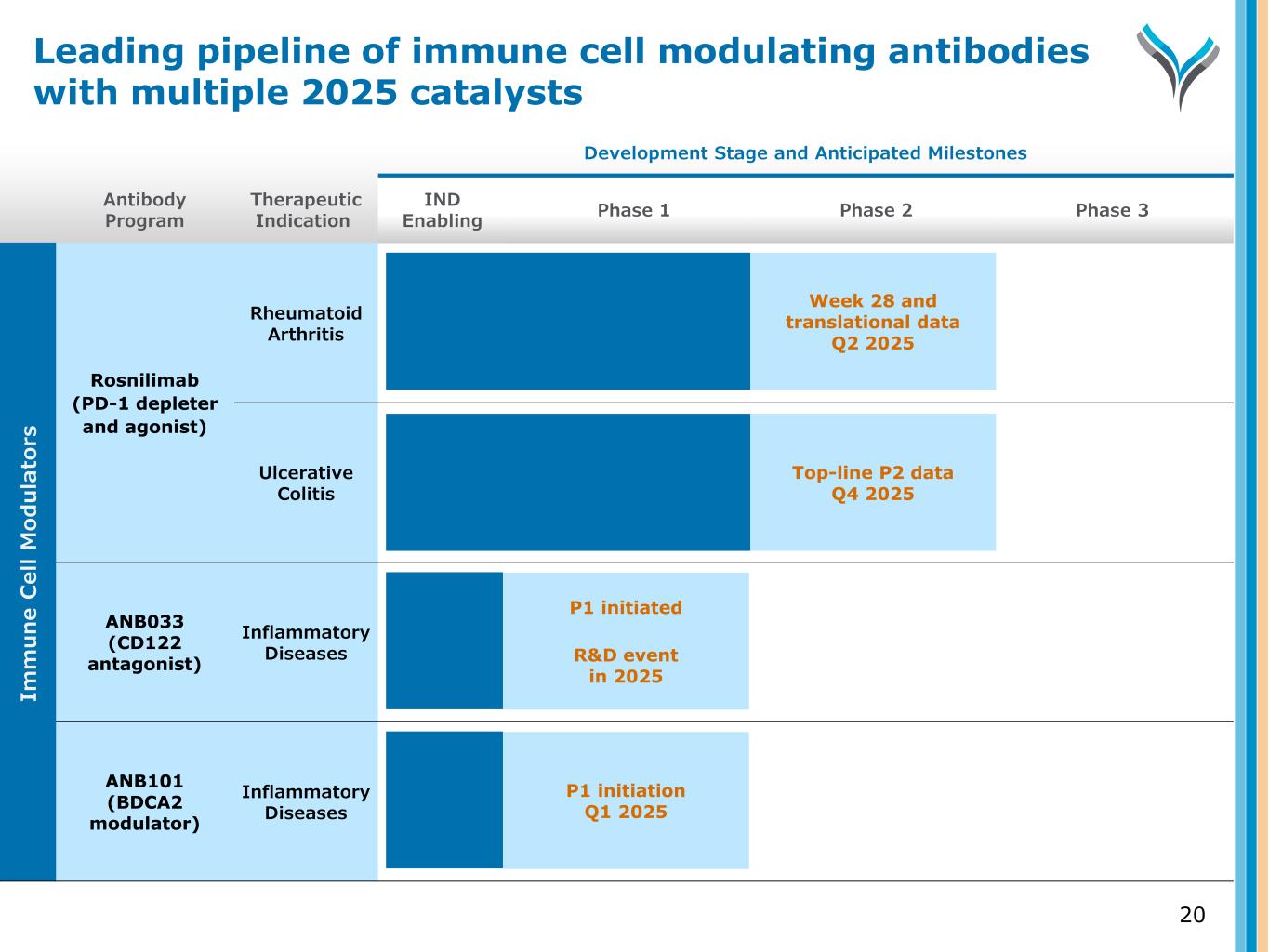
Antibody Program Therapeutic Indication Development Stage and Anticipated Milestones IND Enabling Phase 1 Phase 2 Phase 3 Rosnilimab (PD-1 depleter and agonist) Rheumatoid Arthritis Ulcerative Colitis ANB033 (CD122 antagonist) Inflammatory Diseases ANB101 (BDCA2 modulator) Inflammatory Diseases 20 Week 28 and translational data Q2 2025 Top-line P2 data Q4 2025 P1 initiated R&D event in 2025 Im m u n e C el l M od u la to rs P1 initiation Q1 2025 Leading pipeline of immune cell modulating antibodies with multiple 2025 catalysts



















